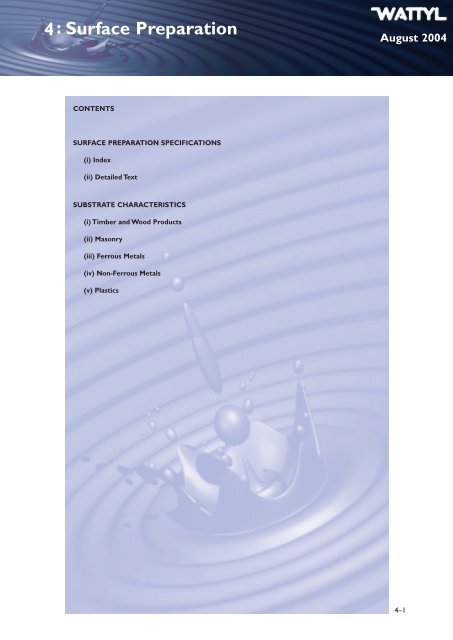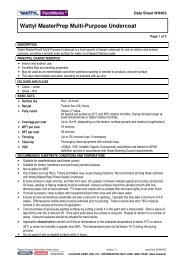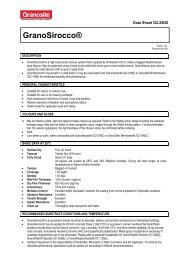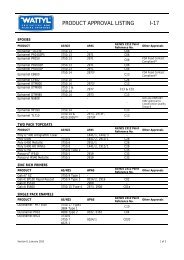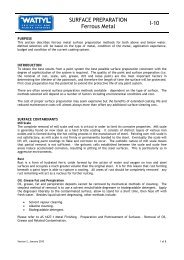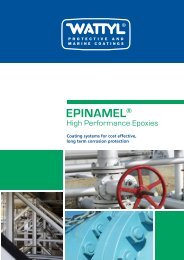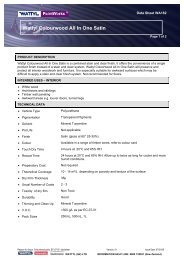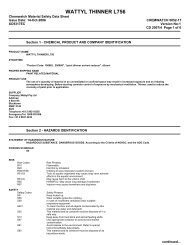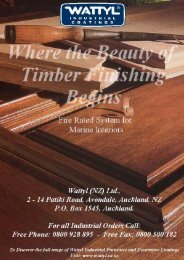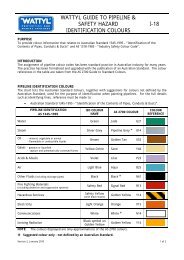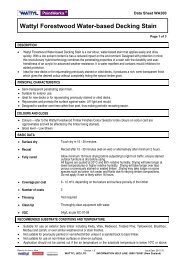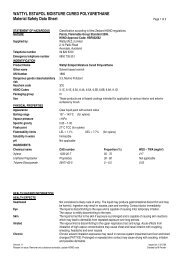Surface Preparation
Surface Preparation
Surface Preparation
Create successful ePaper yourself
Turn your PDF publications into a flip-book with our unique Google optimized e-Paper software.
4 :<strong>Surface</strong> <strong>Preparation</strong>August 2004CONTENTSSURFACE PREPARATION SPECIFICATIONS(i) Index(ii) Detailed TextSUBSTRATE CHARACTERISTICS(i) Timber and Wood Products(ii) Masonry(iii) Ferrous Metals(iv) Non-Ferrous Metals(v) Plastics4–1
4a :<strong>Surface</strong> <strong>Preparation</strong>SpecificationsAugust 2004(i) IndexSP600 Repainting GeneralSP601 <strong>Preparation</strong> of Old Paintwork in Bad ConditionSP602 <strong>Preparation</strong> of Old Chalky PaintworkSP603 <strong>Preparation</strong> of Old Paintwork in Sound ConditionSP604 <strong>Preparation</strong> of Old Paintwork in Good ConditionSP605 Water RinsingSP606 Solvent CleaningSP607 Hand Tool CleaningSP608 Power Tool CleaningSP609 Abrasive Blast CleaningSP609A Abrasive Blast Cleaning, Class 1SP609B Abrasive Blast Cleaning, Class 2SP609C Abrasive Blast Cleaning, Class 2.5SP609D Abrasive Blast Cleaning, Class 3SP609E Brush Blast CleaningSP610 Flame Cleaning Steel <strong>Surface</strong>sSP611 Pickling Steel <strong>Surface</strong>sSP612 <strong>Preparation</strong> of New Wooden <strong>Surface</strong>sSP613 Repair of <strong>Surface</strong> Imperfections in Wooden <strong>Surface</strong>sSP614 Removal of Perished Paint by Power SandingSP615 Removal of Perished Paint by Burning OffSP616 Removal of Perished Paint by Chemical StripperSP617 Removal of Mould and MildewSP618 Removal of Moss and LichenSP619 Removal of Chalk, Dirt and DustSP620 Removal of Grease, Dirt and ScumSP621 Removal of Gloss from Paint and EnamelSP622 Removal of Efflorescence from a Set Plaster <strong>Surface</strong>SP623 Treatment of CopperSP624 Treatment of Medium Density FibreboardSP625 Treatment of PlasticsSP626 Acid Etching of Efflorescent Free Concrete <strong>Surface</strong>sSP627 Repair of <strong>Surface</strong> Imperfections in MasonrySP628 Repair of <strong>Surface</strong> Imperfections in Plaster 2SP629 <strong>Preparation</strong> for Painting Iron and SteelSP630 <strong>Preparation</strong> of Aluminium and AlloysSP631 <strong>Preparation</strong> of Sound Masonry and ConcreteSP632 <strong>Preparation</strong> of Precoated Galvanised Iron SheetingSP633 Filling of Concrete Blocks Prior to PaintingSP634A Ageing of Concrete for Waterbased PaintsSP634B Ageing of Concrete for Alkali Resistant Solvent Based PaintsSP634C Ageing of Concrete for Alkyd Paints4–2
4a :<strong>Surface</strong> <strong>Preparation</strong>SpecificationsAugust 2004SP 600 Repainting General: Ideally paint should break down by gradual erosion of the surfaceleaving a perfectly adhering, etched surface which is ideal for repainting after a simple washdown. Unfortunately this ideal situation does not always occur which necessitates greater surfacepreparation.Breakdown due to loss of Adhesion This is the most serious problem to overcome and caninclude flaking, peeling and blistering. Where any of these breakdowns have occurred, unless specificlocalised reasons for the failure can be identified, it is wise to assume that the weakness could beprevalent over the whole surface.The assessment which has to be made is WHETHER THE EXISTING SYSTEM HAS SUFFICIENTADHESION TO HOLD ON WHEN SUBJECTED TO THE EXTRA STRESS AND WEIGHT OF 2OR 3 MORE COATS OF PAINT. Stresses are, of course, increased if the new system is darker incolour than the existing system.A simple test for adhesion is as follows: Clean an area of suspect coating and apply a strip ofadhesive tape; ensure firm contact by rubbing with a fingernail. Rapidly pull off the tape at 90° tothe surface. Examine the tape for any detached paint. Any poorly adhering paint must be removedby burning, sanding, or solvent strippers. All edges of poorly adhering areas must be featheredand immediately treated with the first coat of the system to prevent “edge curl’ with subsequentweathering.Glossy <strong>Surface</strong>s All surfaces, both interior and exterior, should be thoroughly washed down toensure the removal of all surface contaminants before de-glossing.Enamel paints which have aged in the absence of ultra violet light develop an extremely hard,impermeable surface which is difficult to adhere to. In exterior situations this occurs in shelteredsituations such as the underside of weatherboards and under eaves and soffits. In interior situationsthis condition is almost always prevalent, and the surface can be even more difficult to adhereto due to surface contaminants (e.g. soap contamination in bathrooms, grease contaminationin kitchens). In all cases glossy surfaces must be de-glossed by a thorough sanding to removecontaminants and to provide a mechanical key for subsequent coats.Powdery, Hydrolised, or Saponified Paint In some cases paint can breakdown with acomplete loss of film integrity. This normally occurs when paint has been in contact with alkalis andwith water for long periods of time. It is easily recognisable by its ‘cheesy’ nature, and easy removalwith a fingernail. After removal of the source of the problem (e.g. water leaks), the affected paintmust be totally removed by sanding and scraping before recoating.Mould Infested <strong>Surface</strong>s Refer Data Sheet. SP 617SP601 <strong>Preparation</strong> of Old Paintwork in Bad Condition:Procedure: Remove all paint with a paint scraper, wire brush, by burning off or chemical stripperas appropriate. Wash surfaces down with clean water, allow to dry thoroughly. Fill cracks andsurface imperfections in masonry, with mortar or acrylic filler. Gaps resulting from structuralmovement should be filled (Refer SP613). Allow to dry, sand smooth, dust off. Any degradedsubstrate (e.g. dry rotted timber must be cut out prior to painting and replaced). Timber should befilled with acrylic filler or linseed oil putty, priming first. Remove any resin extracts by scraping offand washing with mineral turpentine. Sand any glossy surfaces to provide key.SP602 <strong>Preparation</strong> of Old Chalky Paintwork:4–3
4a :<strong>Surface</strong> <strong>Preparation</strong>SpecificationsAugust 2004Procedure: Remove as much of the coating as possible by scraping and wire brushing, then washback to sound surface. Refer SP620. Fill cracks and surface imperfections in masonry (SP630).Gaps resulting from structural movement should be filled with flexible gap sealant. Allow patchingcompound to dry, sand smooth, dust off. Apply 1 coat of Acrylic Primer/Undercoat to the entirearea. Allow minimum 24 hours to dry and penetrate fully. Any degraded substrate (e.g. dry rottedtimber) must be cut out prior to painting and replaced. Timber should be filled (refer SP613).Remove any resin extracts by scraping off and washing (refer SP606). Sand any glossy surfaces toprovide key.SP603 <strong>Preparation</strong> of Old Paintwork in Sound Condition:Procedure: When paintwork is chalking but otherwise sound, remove grease, dust, dirt bywashing to SP620. Degraded substrate must be replaced prior to painting. Remove minor flaking orpeeling by sanding, scraping, wire brushing or burning off. Sand any glossy surfaces. Wash down withclean water (SP620), allow to dry, then prime or seal bare areas. When dry, apply 1 coat of AcrylicPrimer/Undercoat to entire area.SP604 <strong>Preparation</strong> of Old Paintwork in Good Condition:Procedure: Remove grease, dust and dirt by washing down with sugar soap (SP620). Sandthoroughly to remove gloss where applicable, smooth all edges with fine paper. Dust off. Removeany resin extracts by scraping off and washing to remove. Refer SP601. Prime or seal bare areaswhere applicable with specified preparation coat.SP605 Water Rinsing:Procedure: Wash thoroughly with fresh water all surfaces requiring the removal of salts andacids. <strong>Surface</strong>s should be washed by either swabbing with clean brushes, rags, etc, wetted frequentlywith clean water or by hosing down from a fresh water supply line. All water vessels used forswabbing down the surfaces should be frequently replenished with clean water. <strong>Surface</strong>s should bedried as quickly as possible by wiping with clean rags and/or blowing with dry, clean compressedair before proceeding with the next operation. Water rinsed surfaces should be coated as soon aspossible, after drying thoroughly, to prevent surface deterioration occurring.SP606 Solvent Cleaning:Procedure: All deposits of oil, grease, or other solvent soluble contaminants should be removedfrom the surface by wiping or scrubbing the surface with rags or brushes wetted with solvent suchas mineral turpentine or white spirit. Final cleaning should be done, by wiping down with cleansolvent, using clean rags or brushes. The surface should be allowed to dry satisfactorily beforeproceeding with the next operation. The solvent cleaned surfaces should be treated or primedimmediately or as soon as possible where chemical contamination of the surface may occur aftercleaning, and before deterioration of the surface occursPrecautions: Ensure adequate protective clothing and eye protection is worn.Reference: Australian Standard 1627, Part 1.SP607 Hand Tool Cleaning:Procedure: Remove all loose millscale, rust and paint by scraper, chipping hammer or impacttool. Clean pits with hand wire brush. Smooth rough edges with emery paper, then clean entirearea with wire brush, wash with solvent and / or water, dry and dust down with clean cloths orcompressed air, and paint as soon as possible.Reference: NZ Std 1627, Part 1.4–4
4a :<strong>Surface</strong> <strong>Preparation</strong>SpecificationsAugust 2004SP608 Power Tool Cleaning Wooden and Steel <strong>Surface</strong>s:Removal Procedure: Remove all loose rust, loose mill scale, loose paint and blistered paint byscraper. All loose mill scale not readily removed by scraper shall be removed by hand or powerwire brushing. Heavy nodules and heavy scale shall be removed by grinder. All burr marks, sharpedges, cuts, etc., made by the various cleaning tools shall be sanded to a smooth finish with sandersor grinders. Wire brush the entire area using rotary power wire brushes (cup or radial type) toclean the surfaces free of all loose residues left after the scraping, chipping, etc.Pressure should be applied to the surface sufficient enough to clean the surface without anydetrimental degree of burnishing the steel, wood or galvanised surface.Equipment Requirements: All power cleaning equipment shall be in good condition and givesatisfactory cleaning of the surface. Steel wire brushes should be sufficiently rigid to clean thesurface and shall be kept free of all foreign matter. These brushes should be discarded when theyare no longer effective.Power grinding wheels or sanding abrasive discs shall be discarded when they become ineffective.Further cleaning and Pre-Treatment After Power Tool Cleaning: All deposits of oil orgrease left on the surface shall be removed from the surface by wiping or scrubbing with brushesor rags wetted with a suitable solvent such as Mineral Turpentine, White Spirit, or in the case ofwooden surfaces, sugar soap or similar.Any residues, such as salts or acids, left on the surface must be thoroughly washed off with cleanfresh water.The surface prior to being treated or primed shall be thoroughly dry before proceeding, andcleaned down with brushes, clean dry compressed air or vacuum to remove all loose andextraneous deposits.The cleaned surface shall be treated or primed as soon as possible and before furtherdeterioration of the surface occurs, particularly where chemical contamination is possible.Degree of <strong>Surface</strong> <strong>Preparation</strong> Required: In all cases the surface shall be cleaned to asatisfactory standard as by this Specification.Special attention shall be given to all areas such as rivet heads, crevices, lap joints, weld areas andangles, to ensure that these sections are cleaned thoroughly by using the power-driven cleaningtools, or combination of such tools, best suited for the operation.Areas of tightly adhered paint not removable by the power tool cleaning shall have all edgesfeathered by sanders to a smooth surface. All remaining paint not removed shall have sufficientadhesion so that it cannot be lifted as a layer by inserting a dull putty knife under it.Precautions: All power tool cleaning equipment shall be used in accordance with themanufacturer’s specifications.SP609 Abrasive Blast Cleaning:Procedure: <strong>Surface</strong>s contaminated with oils, salts, acids or other chemicals should be cleanedprior to abrasive blast cleaning to prevent recirculation of contaminants with abrasive grit. Thesurface should be blast cleaned with the selected process (open dry blasting, closed recirculatedblasting, wet blasting) to the specified NZS1627.4 standard (Clauses 1, 2, 2.5 or 3). The blast4–5
4a :<strong>Surface</strong> <strong>Preparation</strong>SpecificationsAugust 2004cleaned surface should be treated or primed within 4 hours after preparation or before thesurface becomes re-contaminated. Reference: Australian Standard 1627, Part 4.SP609A Abrasive Blast Cleaning Class 1:Procedure: Light blast cleaning: <strong>Surface</strong>s contaminated with oils, salts, acids or other chemicalsshould be cleaned prior to abrasive blast cleaning to prevent recirculation of contaminants withabrasive grit. The surface should be blast cleaned with the selected process (open dry blasting,closed recirculated blasting, wet blasting) to NZS1627.4 Class 1. The blast intensity and distributionshould be such that loose mill scale, loose rust and loose foreign particles are removed. Theblast cleaned surface should be treated or primed within 4 hours after preparation or before thesurface becomes re-contaminated.SP609B Abrasive Blast Cleaning Class 2:Procedure: Medium Blast Cleaning: <strong>Surface</strong>s contaminated with oils, salts, acids or otherchemicals should be cleaned prior to abrasive blast cleaning to prevent recirculation ofcontaminants with abrasive grit. The surface should be blast cleaned with the selected process(open dry blasting, closed recirculated blasting, wet blasting) to W1627.4 Class 2. The blast intensityand distribution are such that mill scale, rust and foreign particles are substantially removed andgrey metal is visible. The blast cleaned surface should be treated or primed within 4 hours ofpreparation or before the surface becomes re-contaminated.SP609C Abrasive Blast Cleaning Class 2.5:Procedure: “Near White” Blast Cleaning. <strong>Surface</strong>s contaminated with oils, salts, acids orother chemicals should be cleaned prior to abrasive blast cleaning to prevent recirculation ofcontaminants with abrasive grit. The surface should be blast cleaned with the selected process(open dry blasting, closed recirculated blasting, wet blasting) to NZS1 627.4, Class 2.5. The blastintensity and distribution are such that mill scale, rust and foreign particles are removed to theextent that the only traces remaining are slight stains in the form of spots and stripes. The blastcleaned surface should be treated or primed within 4 hours of preparation or before the surfacebecomes re-contaminated.SP609D Abrasive Blast Cleaning Class 3:Procedure: “White Metal” Blast Cleaning. <strong>Surface</strong>s contaminated with oils, salts, acids orother chemicals should be cleaned prior to abrasive blast cleaning to prevent recirculation ofcontaminants with abrasive grit. The surface should be blast cleaned with the selected process(open dry blasting, closed recirculated blasting, wet blasting) to NZS1624.4, Class 3. The blastintensity and distribution are such that all mill scale, all rust and all foreign particles are entirelyremoved. The cleaned surface should have a uniform metallic colour. The blast cleaned surfaceshould be treated or primed within 4 hours of preparation or before the surface becomesre-contaminated.SP609E Brush Blast Cleaning:Procedure: <strong>Surface</strong>s contaminated with oils, salts, acids or other chemicals should be cleanedprior to abrasive blast cleaning to prevent recirculation of contaminants with the abrasivemedia. The surface should be blast cleaned with the selected process (open dry blasting, closedrecirculated blasting, wet blasting). The blast intensity and distribution should be such that looseforeign particles, contaminants and oxide layers (on aluminium or galvanised surfaces) are removedonly. The blast-cleaned surface should be treated or primed before the surface becomesre-contaminated.4–6
4a :<strong>Surface</strong> <strong>Preparation</strong>SpecificationsAugust 2004SP610 Flame Cleaning Steel <strong>Surface</strong>s:Procedure: Remove asphalt, tar, heavy rust scale and other foreign matter with suitable tools. Oiland grease should be removed by solvent cleaning (SP606). The surface should be flame cleanedusing oxy-acetylene or oxy-LP gas to remove rust or mill scale with a neutral or slightly oxidisingflame. Paint should be removed with a more oxidising flame. To remove paint move flame at aspeed which only softens the paint, and then remove softened film by scraping. Immediately afterflame cleaning, and while surface is still hot wire brush (hand or power tool) to remove looseparticles then apply primer. Reference: New Zealand Standard 1627, Part 3.SP611 Pickling Steel <strong>Surface</strong>s:Procedure: Solvent cleaning (SP606), alkaline or mechanical cleaning (SP602, SP603) shouldbe used to remove heavy deposits of oil, grease and dirt. Weld spatter and slag should also beremoved before pickling. Mill scale, welding flux and rust are removed by chemical reaction,electrolysis or both using one of the following pickling methods. Sulphuric acid, phosphoric acid,citric acid, hydrochloric acid, alkaline or electrolytic pickling. After pickling, the work should bedrained in a way which will minimise entrapment of pickling solution. Do not allow the work todry out before rinsing. Rinse by hosing or immersing in fresh water baths. Drain, dry and prime assoon as possible. Reference: New Zealand Standard 1627, Part 5.SP612 <strong>Preparation</strong> of New Wooden <strong>Surface</strong>s:Procedure: Ensure the wood is thoroughly dry before commencing. If there is any doubt, measuremoisture content, which must be less than 15% before painting can commence. Examine thesurface for sap or pitch streaks, grease, oil, etc., and exudations from knots. Scrape off any sap orgum exudations and then treat these areas by solvent cleaning (SP606). Using scraper, sandpaper orsteel wool, remove dirt and mortar splashes. Remove all excessive roughness, loose edges, sliversand splinters with sandpaper and prime as soon as possible, preferably the same day if on exteriorexposure to prevent deterioration of surface and re-contamination.Precautions: Do not apply when temperature is below 10°C, the humidity is greater than 85% orif dew or rainfall is likely within 4 hours of application.SP613 Repair of <strong>Surface</strong> Imperfections in Wooden <strong>Surface</strong>s:Procedure: (a) Linseed oil putty: Ensure the surface has been primed. Knead the putty to themost satisfactory state for working and apply to all surface defects, cracks and nail holes, fillingthese until flush with the surface. Allow to dry up to 48 hours when applied to deep holes beforeapplying further coats of paint. (b) Acrylic wood filler: Fix split timber before filling. Make sure areato be filled is clean, sound and dry. It is not necessary to prime before filling. Use a filling knifeand press filler into cavities. Smooth off. Dampen knife for smoother finish. Deep cavities shouldbe filled 1 centimetre at a time and allowed to dry between layers. Leave to dry overnight. Sandsmooth with medium grade glass paper. Clean tools in warm water. For best weather resistancefiller should be primed and painted or stained.SP614 Removal of Perished Paint by Power Sanding:Procedure: Remove the bulk of the cracked, flaked, blistered/loose or thick paint by the use of apower sander with a coarse grade of sandpaper on the grinding wheel. Following coarse sanding,load the power sander with fine sandpaper and “feather” all edges, rough patches, etc. Dust downthe surface.Precautions: Because of the possibility of a lead paint having been used, while the power sanding4–7
4a :<strong>Surface</strong> <strong>Preparation</strong>SpecificationsAugust 2004or dusting operation is being carried out, full protection from the dust must be maintained. Suitableequipment should include complete coverage of all skin and hair and a suitable respirator must beworn.SP615 Removal of Perished Paint by Burning Off:Procedure: Use suitable equipment capable of giving either a flame, or a blast of intense heat,that will soften the paint film. Hold the flame, or nozzle, at an angle about 2 centimetres fromthe surface and about 5 centimetres ahead of the scraper, which is used to remove the paint asit bubbles and softens. All burning off must be carried out in accordance with NZSS 2239:1980Section 501.5.2.1(A)Precautions: When wooden surfaces are being burned off, ensure that the wood is not charredby the flame. Keep the flame away from loose joints, knot holes, cracks, and from underside ofweatherboards. Ensure no easily ignited materials are concealed on the surface to be burned off, bythorough inspection of the surface before cleaning commences.SP616 Removal of Perished Paint by Chemical Stripper:Procedure: Apply a liberal coat of the stripper by brush to the surface of the film to be removed.Allow to stand until the paint is softened and then scrape the paint from the surface. Repeat theoperation until the removal is complete. Solvent clean the surface, in accordance with SP606, thensand in accordance with SP612.Precautions: Ensure adequate protective clothing and eye protection is worn.SP617 Removal of Mould and Mildew:Procedure: Using a hard brush, remove all loose and powdery deposits from the infected areas.Make a dilute solution of hypochlorite (household bleach) by diluting one part with three parts ofclean water. Apply this diluted solution to the infected areas by swabbing with a clean cloth. Allowthe solution to remain on the surface for 10-20 minutes (depending on intensity of growth) andrinse off with clean water. Apply second treatment if necessary. Allow to dry thoroughly.Precautions: Ensure adequate protective clothing and eye protection is worn.SP618 Removal of Moss and Lichen Growth:Procedure: Using a hard brush or broom, remove all loose and powdery deposits from the areasexhibiting the growth. Remove moss and lichen using a commercial moss/lichen remover. Rinse welland allow to dry fully.Precautions: Ensure adequate protective clothing and eye protection is worn.SP619 Removal of Chalk, Dirt and Dust:Procedure: Using a stiff bristle brush, dust the surface down. Excessive chalk, which remains afterthis treatment should be removed by scrubbing the surface with a stiff brush using clean water. Thesurface should then be hosed clean and allowed to dry.SP620 Removal of Grease, Dirt and Scum:Procedure: Wash down, using either hot or cold water, in which is dissolved soap powder ordetergent - or wash the surface with a commercial paint cleaner. This washing should be repeatedin the case of extremely dirty surfaces. After washing the surface as above, a thorough rinsing withclean water should be carried out. The surface should then be allowed to dry.4–8
4a :<strong>Surface</strong> <strong>Preparation</strong>SpecificationsAugust 2004SP621 Removal of Gloss from Paint and Enamel:Procedure: Wash surface down with solution of detergent or sugar soap. Lightly abrade surfacewith fine sandpaper to remove gloss, wipe down with fresh detergent solution and then cleanwater and allow to dry.SP622 Removal of Efflorescence from a Set Plaster <strong>Surface</strong>:Procedure: Wipe the efflorescence from a portion of the surface with a clean, dry rag. Allow thewiped surface to age for a few days, then examine for efflorescence. If present, wipe down againand re-examine again after a few days. Continue this operation until efflorescence ceases.Once efflorescence has ceased, treat affected area with a commercial lime scale remover followingmanufacturers directions.Rinse well and allow to dry.Precautions: A paint film will not stop efflorescence if it is still active. It is essential to ensure thatthe efflorescent action has ceased prior to painting.SP623 Treatment of Copper:Procedure: Oil, grease, etc., shall be removed by solvent cleaning in accordance with SP606.Using medium grade abrasive paper and white spirit as lubricant, scuff lightly to obtain a uniformlyetched surface. If a bright surface is required for decorative purposes, clean as above, then makeup a solution as follows: salt 40 mls, white vinegar 1 litre. Apply the solution by pad, and then washdown with clean water. Allow to dry, and then apply finish immediately.SP624 Treatment of Medium Density Fibreboard (e.g. Craftwood, Customwood, etc.)Procedure: Including moisture resistant grades: Repair imperfections and fill nail holes (SP613).Sand smooth, cut edges and dust down. Apply primer and if necessary re-sand cut edges to smoothdown raised fibres.SP625 Treatment of Plastics:Procedure: Plastic surfaces should be wiped down with solvent and clean cloths to removeall grease, dirt and other contaminants. Test an inconspicuous area with the selected solventbefore cleaning to determine the plastics solvent sensitivity. For solvent sensitive plastics (ABS,polycarbonate, polystyrene, PVC) thoroughly clean with methylated spirits, isopropanol or warmwater and detergent. For non-solvent isopropanol sensitive and thermoset plastics (polyester,phenol/ formaldehyde, polyurethane, polypropylene, polyethylene, etc.) thoroughly clean withsuitable solvent (mineral turpentine or white spirit). If possible, do not sand or abrade plasticsurface as this will introduce scratch marks which show through the coating. Where needed abradewith nylon pad, steelwool or fine (P800) wet and dry paper (Refer New Zealand Standard KS7703,Part 3.12).4–9
4a :<strong>Surface</strong> <strong>Preparation</strong>SpecificationsAugust 2004SP626 Acid Etching of Efflorescent Free Concrete <strong>Surface</strong>s:Procedure: Prepare acid solution by adding 1 part of commercial 32% hydrochloric acid to 2parts by volume of water. Do not add water to acid. Apply at approximately 3 square metresper litre. Remove all dust, dirt, etc, from the surface to be treated, then apply a 10% solution ofhydrochloric acid by brush or mop, flowing the acid on to the surface. Allow the acid to remain onthe surface for approximately 15 minutes and then thoroughly rinse the treated areas with liberalquantities of clean water.Precautions: Ensure adequate protective clothing and eye protection is worn. Thoroughly rinsewith copious quantities of clean water if the skin is splashed. If swallowed, seek medical advice.SP627 Repair of <strong>Surface</strong> Imperfections in Masonry:Procedure: Ensure surfaces are clean, dry and free from loose material. Deep holes in masonryshould be first filled with mortar or an acrylic based filler as directed. Fine holes should beundercut to aid adhesion. Priming is unnecessary before use. Pack firmly with filling knife. Dampenknife for a smoother finish. Deep cavities should be filled 1 centimetre at a time and allow to drybetween layers. Sand smooth and paint as required when dry. Highly glazed brickwork may need tobe roughened with a grinder to achieve adequate paint adhesion.SP628 Repair of <strong>Surface</strong> Imperfections in Paperfaced Plasterboard, Fibrousor Set Plaster:Procedure: Fill cracks and surface imperfections with patching plaster or a ready mixed filler. Anygaps resulting from structural movement should be filled with a flexible gap sealant. Sandpapersmooth, and dust off thoroughly to remove loosely adhering jointing compound or cornice cement.SP629 <strong>Preparation</strong> for Painting Iron and Steel:Procedure: <strong>Surface</strong>s should be thoroughly dry and cleaned free of dust, grease and dirt. All rust,mill scale should be removed by scraper or wire brush (Refer SP607), and rust affected areastreated with a rust remover. Dust off, and then apply specified coatings without delay as any rustingwill detract from adhesion.SP630 <strong>Preparation</strong> of Aluminium and Aluminium-Alloy <strong>Surface</strong>s:Procedure: Aluminium surfaces are usually smooth and do not provide a good key for adhesionof paint. To improve adhesion surfaces should be solvent cleaned (SP606), solvent spray cleaned orvapour degreased. The surface should be washed thoroughly, dried, primed and painted as soon aspossible, preferably on the same day.SP631 <strong>Preparation</strong> of Sound Masonry and Concrete:Procedure: Remove loose dirt, sand, aggregate or mortar by brushing down or blocking-offsurface with flat brick, block or other tool. Dust down and wash surface with fresh water. Pre-treatany exposed metal, nails, reinforcing rods, etc., fill holes and flaws with mortar or approved patchingfiller, treat fresh masonry, concrete (SP629) and paint before re-contamination can occur.SP632 <strong>Preparation</strong> of Precoated Galvanised Iron Sheeting:Procedure: For small areas; sand, ensuring all gloss is removed. For larger areas abrade the surfaceby either low pressure blasting with a sand/water slurry or high pressure water spray while scuffingwith a long bristle broom. Avoid scuffing back to bare metal. Clean the surface by solvent wipingwith mineral turpentine (SP606) and wipe dry with clean rags.4–10
4a :<strong>Surface</strong> <strong>Preparation</strong>SpecificationsAugust 2004SP633 Filling of Concrete Blocks Prior to Painting:Procedure: Where a smooth finish is required on concrete blocks, a liberal coat of exterior gradeblock filler should be applied by roller prior to the application of finishing coats. Allow to dry asper manufacturers instructions. For very open block work, a second coat of block filler may benecessary. Where blocks are very open or where a smooth even coat of paint is required, 12 mmof cement render should be applied as the alternative to block filler.SP634 Ageing of Concrete:Procedure: New concrete and masonry surfaces are best left to dry and cure for extensiveperiods although surface treatments with acids and salts have been used successfully (SP627).Ageing or curing times of concrete depend on the paint finish specified and concrete thickness. Thefollowing times are suggested for surfaces exposed to normal drying processes (at 20°C and 65%RH) and not subject to continued sources of moisture or rain.A). Water based paints. Mortar, render, cement block, unfilled block work: age for 4 weeks. Cast insitu and pre-cast concrete, filled block work: age for 8 weeks.B). Alkali resistant solvent based paints. Mortar, render, cement brick, unfilled block: age for 6 weeks.Cast in situ and pre-cast concrete, filled block: age for 12 weeks.C). Alkyd paints. Mortar, render, cement brick, unfilled block: age for 12 weeks. Cast in situ andprecast concrete, filled block: age for 16 weeks. Drying period should be extended by 4 weeks foreach 25 mm thickness over 100 mm.4–11
4b :Subrate CharacteristicsAugust 2004Substrate Characteristics(i) TIMBER AND WOOD PRODUCTSA great diversity of timber products are found in the building industry ranging from extensivestructural elements to purely decorative items and surfaces. Clearly different types of timbersexhibit a wide range of characteristics, which even within a single species can vary greatly. Suchvariations occur in colour, density, strength and durability. These inherent variable characteristicsgive timber its unique beauty and appearance as well as being the origin of its sometimes difficultnature to paint.The effect of such variation in properties is not of great importance in interior applications whereappearance is usually the principal function. Indeed in such applications these variations result indesirable and attractive effects.Clearly for structural components uniformity of composition and strength are essential.In exterior applications however, properties such as dimensional stability, moisture absorptionand durability are most important, affecting the service life of the timber and the surface coating.Paint films are usually applied to exterior surfaces to prolong the life of the timber product, aswell as for decorative effect. The paints and substrate timber must therefore be suitably matchedto achieve optimum performance. This means that the coating system must be properly appliedand maintained over good substrates. Timber containing joints, knot-holes, resins, etc often placehigh stress on coatings because of variable expansion and contraction. This can quickly lead tocracking, flaking and peeling of paint films, especially if moisture enters through cracks, end-grain orpanel backs. Hence there is a need to use sound and uniform substrate timber in conjunction withcomplete surface preparation and coverage.Timber is prone to degradation by exposure and biological attack. Sunlight and UV can degradewood components causing it to lose colour (goes grey) and surface integrity.Similarly if surfaces remain damp (greater than 22% moisture) biological attack by mould and fungican occur and may cause extensive damage both structurally and superficially.It is therefore important that timber is used in appropriate areas, that components are welldesigned, and that appropriate types of timber are used. Generally it is recognised that hardwoodsare more dimensionally stable and more durable than softwoods, with resinous softwoods (cedar,teak) being more durable that non-resinous softwoods. When choosing the type of wood for aparticular application, its cost, conditions of service and appearance must be considered.Short-term exposure of unprotected timber on building sites or during construction, prior topriming, also allows the partial degradation of surface layers of timber. This is often seen as loss ofcolour on the timber surface. To ensure that a long service life is achieved from the coating theexposed timber surface should be sanded before priming. Ideally timber products should be storedin protected areas on construction sites wherever possible.Some timber products, such as, windows, doors and frames are treated with temporary coatings bymanufacturers. While these coatings do not generally adversely affect the performance of the finalsystem, care must be taken that excessive amounts of these temporary finishes are not present orpremature loss of adhesion and durability may result.4–12
4b :Subrate CharacteristicsAugust 2004Particleboards and PlywoodsThese boards are frequently used as flooring and panelled areas, which are to be painted, tiledor covered in some way. They consist of particles or veneers of wood bound together witha synthetic resin. They should be used only in interior applications and preferably not in highhumidity areas, unless moisture resistant grades are used.<strong>Surface</strong>s of particleboards are usually difficult to get a high standard of finish with gloss paintswithout surface filling. This is especially true when using water based paints as the wood particlesexpand in the presence of water. Plywoods on the other hand can be finished in the same manneras normal timber substrates.(ii) MASONRY - BRICKS, STONE, CONCRETE, RENDER, BLOCKWORKConcrete and masonry building materials lend themselves to high production building methodsand innovative styling. With increased scrutiny on maintenance cost, life cycle costing, increasedawareness of acid rain and chemical attack on building materials, specifiers are seeking decorativefinishes that will meet demanding performance criteria to enhance and protect these structures.However, concrete and masonry have special needs, which must be met to ensure optimumperformance of the substrate and its coating to give:• fast and effective coverage of marginal substrates• long lasting protection from moisture and atmospheric pollutants• dirt shedding characteristics.General These materials are described as “wet” materials of construction as water is used tomake them up during construction.Excessive moisture can affect the adhesion of most types of paints, causing blistering, flaking andmould growth. Water can also draw salts to the surface as it evaporates and may bring alkali to thesurface causing saponification of some paints. It is important therefore that these surfaces are asdry as possible before paint is applied.Clay Brick and Stonework These surfaces are usually straightforward to paint and present veryfew problems. Ensure that the surface is clean and free of dust, oils and white fluffy efflorescence.Large defects, holes, cracks, etc, should be repaired before painting.Concrete and Cement <strong>Surface</strong>s (Cast In Situ and Pre-cast Concrete, Block work, etc.) Thesesurfaces should be allowed to cure before painting. As a rule allow 1 month drying time for each25mm thickness of concrete. Excessive alkalinity will cause paint to lose adhesion and fail. Alkaliresistant paints can provide a measure of resistance and can be applied to surfaces in which alkalimay be present but the surface is substantially dry.The presence of mould release agents, bond breakers and form oils on cast or pre-cast concretesurfaces will cause premature failure of paint by loss of adhesion. The surface can be checked forthe presence of these oils by splashing with water, if water is repelled or beads on the surface itneeds further cleaning.Other problems, such as form marks and misalignments should be reduced by grinding back if aflush surface is required. Exposed metal such as reinforcing rods, tie wire, metal chain legs, shouldbe treated against corrosion and patched over if possible.4–13
4b :Subrate CharacteristicsAugust 2004The texture of concrete surfaces does not effect the selection of paint type but will affect thequantity of paint required to cover the surface.Plaster Set plaster and plasterboard surfaces used internally generally show very few paintingproblems if good practices are employed, and jointed areas are smoothly finished. Paperfacedsurfaces should not be scuffed up by sandpaper during finishing as this gives a coarse unevenappearance when painted.(iii) FERROUS METALSWhile steel in its various forms is usually used for its structural strength it does need to beprotected from atmospheric pollutants, water, and other chemicals which cause corrosion. Oncestarted, corrosion is a self-perpetuating process and can quickly lead to serious weakening ofstructures and building fabrics, as well as unsightly rust stains on concrete or coated areas.It is therefore important that one of the elements in protecting iron and steel products fromcorrosion is to prevent contact with these environmental chemicals by the use of Barrier orProtective Coatings.Other mechanisms against corrosion are:Galvanic or sacrificial protection of another metal such as zinc cathodes or using chemicalpassivates such as chromates and phosphates.Two main types of steel are usually encountered although there are of course many more. Theseare COLD-ROLLED and HOT-ROLLED STEEL. Each of these need different surface preparationdue to their different manufacturing processes.HOT-ROLLED STEEL is produced with a thin layer of oxide (mill scale) on the surface whichadheres tightly when new but becomes easily detached on weathering. It is essential that this isremoved for long-lasting coating performance. Mill scale can be removed by HAND or POWERTOOL CLEANING or by BLAST CLEANING, the latter being the most effective method. Blastcleaning is done by mechanical shot-blasting, pneumatic abrasive blasting or wet abrasive blasting tospecified standard blast-cleaning grades (Class 1, 2, 2.5 or 3).COLD-ROLLED STEEL and WROUGHT IRON on the other hand are generally free from millscale and only requires the removal of oils or rust deposits by the above methods.The cleaned surfaces should be primed as soon as possible, within a few hours, to avoidrecontamination and to avoid flash rusting from moisture in the atmosphere, then top coated withthe coating appropriate to the end-use and degree of exposure.(iv) NON-FERROUS METALS(Hot Dip galvanised and Zinc Thermal Sprayed Steel, Aluminium, Zinc, Copper, Brass, Lead, etc.)These metals are not used for general structural purposes but for cladding, decorative effects, orprotection of steel substrates. Zinc (galvanising) is generally employed as a coating on steelworkby electrolytic or molten deposition. Both zinc and aluminium and their alloys are used in metalspraying where the steel surface is sprayed with molten metal.Although these non-ferrous metals do not “rust” they do corrode in normal, industrial or marineenvironments.4–14
4b :Subrate CharacteristicsAugust 2004The corrosion by-products, oxides, act as a protective layer and prevent further corrosion, but mayimpair adhesion of paint coatings to the surface.In areas where chemical attack may occur some of these metals should not be specified as theymay be attacked more severely than specially selected steels.Special Problems of Non-Ferrous Metals:Galvanised <strong>Surface</strong>s: New galvanised structural steel surfaces may have flux or other meltbathcontaminants present which need to be removed. Oily galvanised surfaces will need to bedegreased before priming. Zinc or galvanised surfaces should not be painted with alkyd paintsdirect to metal as zinc embrittlement of the paint will occur and early failure by peeling willresult. Always use appropriate primer before painting. Clean new and old galvanised surfaces wellbefore painting.Aluminium, Copper, Brass, Lead, and Chrome: While not normally painted, these metals do notpresent problems in painting unless especially smooth and / or when new. They should be cleanedand finely abraded before coating.(v) PLASTICSGenerally such components are best not painted and are usually manufactured in the end-usecolour. Painting is only required for decorative purposes where blending into existing colourschemes is desirable, e.g. downpipes and guttering.In these exterior applications paints can inhibit solar degradation of plastics, although the use ofinherently weather resistant grades of plastic is preferred.Painting of plastic items can be difficult due to surface tension effects and the inability of sometypes of paints to “wet” the surface. Textured plastic surfaces are generally more readily paintedthan smooth ones.It is very important to specify carefully or know the chemical nature of the plastic as this caninfluence greatly its performance and the paint system required. Many plastics are very difficultto paint without specialist preparation (polyethylene, polypropylene, fluoro plastic, plasticisedPVC). Others are sensitive to some solvents (polystyrene, polycarbonate, perspex). Some of thesehowever can be painted with water based paints quite successfully.Plastic surfaces cannot always be readily abraded as scratch marks often show through the thinpaint film. Oils and mould release agents must be carefully removed.Generally, with conventional surface preparation adhesion of paints to plastic can only be regardedas moderately successful.4–15


